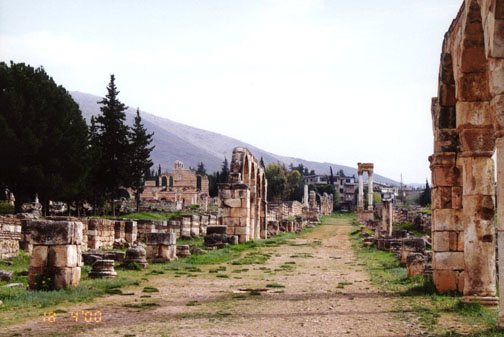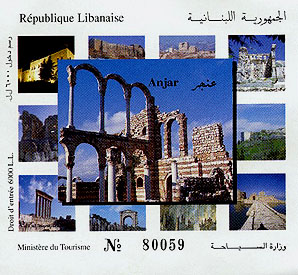

Anjar
An Umayyad City

the site with great palace in the background

a tourist attraction
Umayyad, also Omayyad, first great Arab Muslim dynasty of caliphs (religious and secular leaders) founded by Muawiyah I in 661 and lasting until 750. Uthman ibn Affan, a member of the prominent Umayyad family of Mecca, had been elected to the caliphate in 644 to succeed Umar I, but his weakness and nepotism resulted in rebellion and he was murdered in 656. Uthman was succeeded by Ali, son-in-law of the prophet Muhammad and chief of the legitimist party, which believed that only a member of Muhammadís family could rightfully hold the caliphate. However, Muawiyah I, governor of Syria and first Umayyad caliph, revolted against Ali and, supported by Amr, the conqueror of Egypt, gained the advantage. Hailed as caliph at Jerusalem in 660, Muawiyah I was in complete control soon after the assassination of Ali the following year.
city was a trade center
(600 shops have been uncovered)Under Muawiyah I the capital was changed from Medina to Damascus. Muawiyah I developed an administrative system modeled after the Byzantine Empire and before his death in 680 had secured the throne for his son, thus putting the state on a dynastic basis. Conquest was begun again with an offensive on all fronts. Under Muawiyah I and his Umayyad successors, Muslim control of the Mediterranean region was completed. The Arabs, led by a fierce North African Berber army commanded by Tariq, crossed from North Africa and eventually conquered Spain; in the east they met no effective opposition until they had passed the borders of India. They were stopped in the west by the Franks under Charles Martel and by the Byzantine Empire, which repulsed an attack on Constantinople early in the 8th century.
Anti-Lebanon Mountains in the background
(separates Lebanon from Syria)(
Anti-Lebanon or Anti-Liban (Greek Antilibanus; Arabic Jabal ash Sharqi, "Eastern Mountain"), mountain range located in southwestern Syria and eastern Lebanon, about 145 km (about 90 mi) long. The crest of the range forms much of the border between the two countries. The range extends from the plain around the Syrian city of Hims in the north to Mount Hermon in the south. The Anti-Lebanon is separated from the Lebanon Mountains to the west by a fertile valley, the ancient Coele-Syria (now BekŠa Valley, or Bekaa Valley), which lies in both Lebanon and Syria. A road connects Damascus, Syria, to Beirut, Lebanon. Some geographers refer to the two ranges together as the Lebanons. The Anti-Lebanon has few trees and its northern section is barren and rocky. The highest peaks are Mount Hermon (2814 m/9232 ft), which is the source of the Jordan River, and Tal at Musa (about 2669 m/8755 ft). East of the Anti-Lebanon range is the site of the Old Testament city of HelbŻn.)
Great Palace in background
Under the Umayyad dynasty, political and social ascendancy remained in the hands of a few Arab families from Mecca and Medina. This caused the Muslim population, which had grown enormously as the empire expanded, to become increasingly discontented, especially since the Umayyads had found it necessary to increase their income from taxation. Lands were now taxed without regard to religion, and Muslims were exempt only from personal taxes.
Great Palace
interior
Opposition centered in Persia where there was continued opposition to Syrian domination and where the legitimists allied themselves with the Abbasids, who claimed descent from Abbas, the uncle of the prophet Muhammad. The Abbasids overthrew the Umayyads in 750, killed the caliph, Marwan II, and gained the caliphate for themselves. Members of the Umayyad family were located and slain, except for Abd-ar-Rahman I, who escaped to Cůrdoba, Spain, in 756 to rule as an independent emir. The Abbasids moved the capital of the empire eastward to a new city, Baghd‚d, which they founded on the Tigris River.
Text from Microsoft Encarta
![]()
![]()